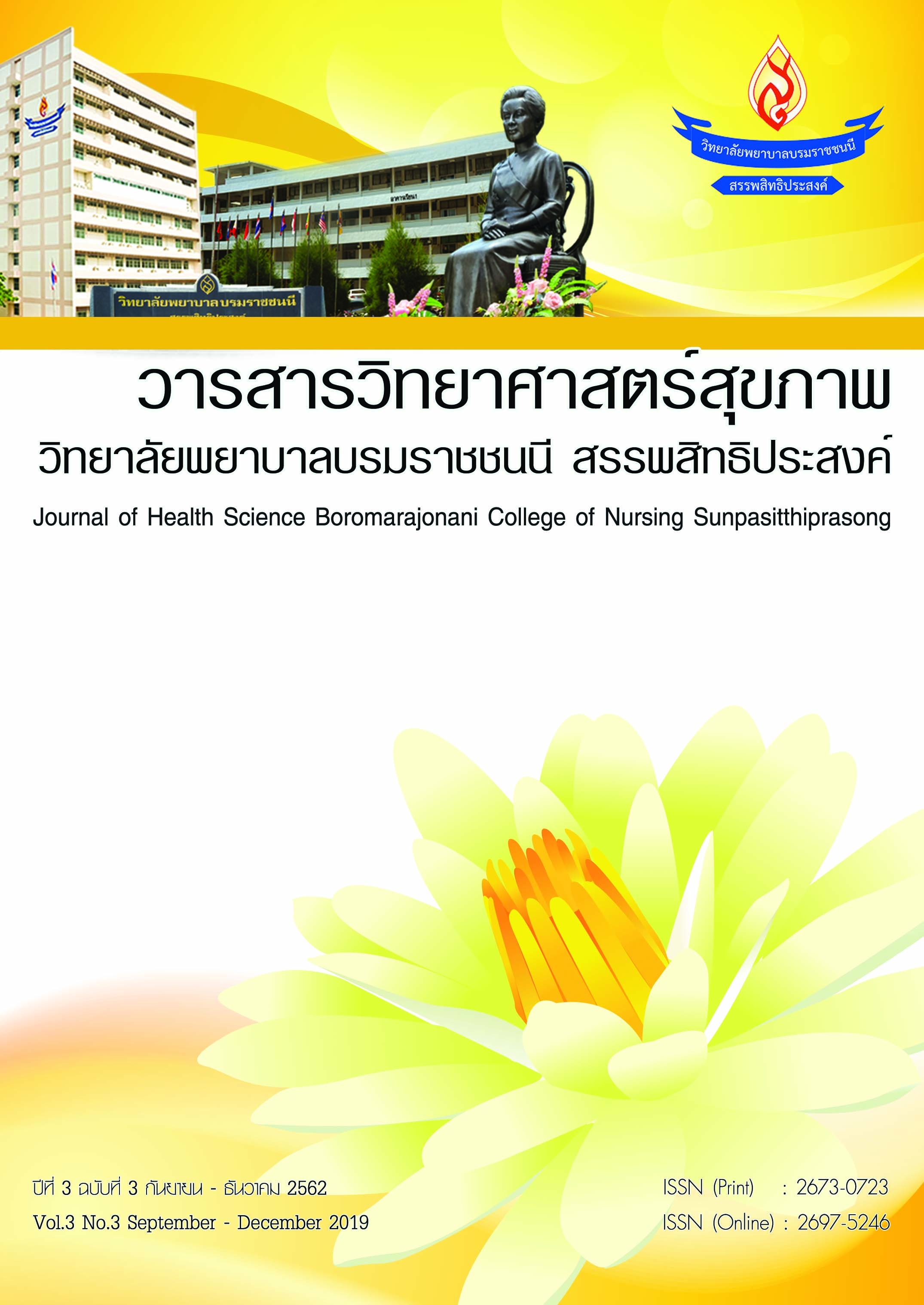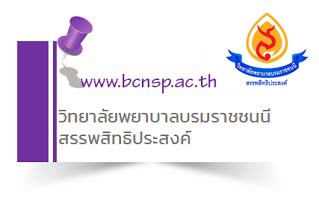ความชุก ปัจจัยเสี่ยงและการพยาบาลผู้ป่วยดึงท่อช่วยหายใจออกเองและท่อช่วยหายใจเลื่อนหลุดโดยไม่ได้วางแผน : การทบทวนวรรณกรรมแบบบูรณาการ
คำสำคัญ:
ท่อช่วยหายใจเลื่อนหลุด, การพยาบาล, การทบทวนวรรณกรรมอย่างบูรณาการบทคัดย่อ
การศึกษานี้มีวัตถุประสงค์เพื่อสังเคราะห์องค์ความรู้เกี่ยวกับความชุก ปัจจัยเสี่ยงและการพยาบาลผู้ป่วยดึงท่อช่วยหายใจออกเองและท่อช่วยหายใจเลื่อนหลุดโดยไม่ได้วางแผน (UE) วิธีดำเนินการเป็นการทบทวนวรรณกรรมแบบบูรณาการ ของ Cooper และสืบค้นจากฐานข้อมูล CINAHL และ ThaiJO ระหว่างปี 2000 - 2018 ผลการศึกษาพบเอกสารทั้งหมดจำนวน 44 เรื่อง เข้าได้กับเกณฑ์จำนวน 16 เรื่อง สังเคราะห์องค์ความรู้ได้ 3 ประเด็นดังนี้ 1) ความชุกการเกิด UE แตกต่างกันโดยผู้ป่วยเด็กอยู่ระหว่าง 0.14-5.3 : 100 วันคาท่อช่วยหายใจแต่ในผู้ใหญ่พบความชุกเฉลี่ย 7.5: 1,000 วันคาท่อช่วยหายใจ 2) ปัจจัยที่เกี่ยวข้องได้แก่สัดส่วนพยาบาล: ผู้ป่วย ≥ 1:3 การขาดแผนการรักษาเรื่องการหย่าเครื่องช่วยหายใจและขาดการได้รับยาที่ทำให้ผู้ป่วยสงบ (Sedative) โดยเฉพาะผู้ป่วยที่กระสับกระส่าย ขาดแนวทางการผูกยึดผู้ป่วยและการยึดตรึงท่อช่วยหายใจที่ไม่แน่น พบขณะที่ให้การดูแลผู้ป่วยข้างเตียงหรือขณะทำหัตถการต่างๆ ผู้ป่วยที่ดึงท่อช่วยหายใจออกเองส่วนใหญ่ร้อยละ 89.7 ไม่ได้รับการใส่ท่อช่วยหายใจใหม่ 3) การพยาบาลมีการพัฒนาประสิทธิภาพการสื่อสารและการพัฒนาแนวปฏิบัติการพยาบาลและการพัฒนานวัตกรรมในการประเมินการหย่าเครื่องช่วยหายใจ (BWAP) และนวัตกรรมวงล้อในการผูกยึดผู้ป่วย สรุปความชุกการดึงท่อช่วยหายใจออกเองในเด็กและผู้ใหญ่พบแตกต่างกันปัจจัยเสี่ยงมีทั้งปัจจัยนำเข้าและกระบวนการดูแลผู้ป่วยซึ่งยังต้องการการพัฒนาให้มีประสิทธิภาพยิ่งขึ้น ควรส่งเสริมให้พยาบาลนำแนวปฏิบัติการพยาบาลที่มีประสิทธิภาพและเครื่องมือต่างๆ มาใช้ในการดูแลผู้ป่วยและการพัฒนานวัตกรรมต่างๆ เพื่อช่วยลดการดึงท่อช่วยหายใจ
References
2.Silva PSL, Reis ME, Aguiar VE, Fonseca MC. Unplanned extubation in the neonatal ICU: A systematic review, critical appraisal, and evidence –based recommendations. Respiratory Care 2013;58:1237-45.
3.Silva PSL, Fonseca MCM. Incidence and risk Factors for cardiovascular collapse after unplanned extubations in the pediatric ICU. Respiratory Care 2017;62:896-903.
4.Tanios M, Epstein S, Grzeskowiak M, Nguyen M, Park H, Leo J. Influence of sedation strategies on unplanned extubation in a mixed intensive care unit. Journal of Critical Care 2014;23:306-15.
5.Cooper H. Synthesizing research: A guide for literature reviews. 3rd ed. London: SAGE Publications; 1998.
6.Rasmussen L, O’Conner M, Shinkle S, Thomas MK. The basic research review check list. The Journal of Continuing Education in Nursing 2000;31:13-7.
7.The Joanna Briggs Institute. New JBI Levels of Evidence [Internet]. 2013 [cited 2019 July 24]. Available from: https://joannabriggs.org/jbi-approach.html#tabbed-nav=Levels-of-Evidence
8.Crezee K, DiGeronimo RJ, Rigby MJ, Carter RC, Patel S. Reducing Unplanned extubations in the NICU following implementation of a standardized approach. Respir Care 2017;62:1030-5.
9.Menon K, Dundon B, Twolan BL & AL, Shammari S. Approach to unplanned extubations in a pediatric intensive care unit. Canadian Journal of Critical Care Nursing 2015;26:25-9.
10.Powell BM, Gilbert E, Volsko TA. Reducing unplanned extubations in the NICU using lean methodology. Respir Care 2016;61:1567-72.
11.Tripathi S, Nunez DJ, Katyal C, Ushay HM. Plan to have no unplanned: A collaborative, hospital-based quality –improvedment project to reduce the rate of unplanned extubations in the pediatric ICU. Respir Care 2015;601105-12.
12.Jarachovic M, Mason M, Kerber K, McNett M. The role of standardized protocols in unplanned extubations in a medical intensive care unit. Critical Care 2011;20:304-12.
13.Hevener S. Rickabaugh B, Marsh T. Using a decision wheel to reduce use of restraints in a medical-surgical intensive care unit. American Journal of Critical Care 2016;25:479-86.
14.Richmond AL, Jarog DL, Hanson VM. Unplaned extubation in adult critical care quality improvement and education payoff. Critical Care Nurse 2004;24:32-7.
15.บังอร นาคฤทธิ์, อำภาพร นามวงศ์พรหม, น้ำอ้อย ภักดีวงศ์. การเลื่อนหลุดของท่อช่วยหายใจและระยะเวลาการใส่เครื่องช่วยหายใจในผู้ป่วยวิกฤตที่ได้รับการดูแลโดยใช้แนวปฏิบัติการพยาบาลที่สร้างจากหลักฐานเชิงประจักษ์. วารสารเกื้อการุญย์ 2558;22:129-43.
16.วิภารัตน์ นาวารัตน์, พนมพร พฤทธิพงศ์พันธ์, ปริชาติ ศรีอนุรักษ์, ปทุมพร กานยะคามิน, สุวีณา เบาะเปลี่ยน. ผลของการใช้แนวปฏิบัติการพยาบาลเพื่อป้องกันท่อช่วยหายใจเลื่อนหลุดโดยไม่ได้วางแผนต่ออัตราการเลื่อนหลุดของท่อช่วยหายใจในหอผู้ป่วยอายุรกรรม โรงพยาบาลพระมงกุฎเกล้า.วารสารพยาบาลทหารบก 2560;18:167-75.
17.มณีนุช สุทธสนธิ์, ขนิษฐา แก้วกัลยา, วาสนา นัยพัฒน์. ผลของการใช้แนวปฏิบัติการพยาบาลต่ออัตราการเกิดท่อช่วยหายใจเลื่อนหลุดในผู้ป่วยอาการหนักที่ใส่ท่อช่วยหายใจ . วารสารพยาบาลและการศึกษา 2560;10:58-70.
18.อุดมลักษณ์ เตียเตียสวัสดิ์, ดลวิวัฒน์ แสนโสม, อัจฉราวรรณ นาเมืองจันทร์, สุภาพรณ์ ตัณฑ์สุระ, ยุวดี บุญลอย, อภิสรา ส่งเสริม. การพัฒนาแนวปฏิบัติการพยาบาลผู้ป่วยใช้เครื่องช่วยหายใจในงานดูแลผู้ป่วยหนัก โรงพยาบาลขอนแก่น. วารสารการพยาบาลและการดูแลสุขภาพ 2560;35:194-206.
19.สมพร นรขุน, รัชนี นามจันทรา, วารินทร์ บินโฮเซ็น. ผลของการใช้แนวปฏิบัติการพยาบาลต่ออัตราการถอดท่อช่วยหายใจในผู้ป่วยใส่ท่อช่วยหายใจ. วารสารพยาบาลโรคหัวใจและทรวงอก 2559;27:72-84.
Downloads
เผยแพร่แล้ว
How to Cite
ฉบับ
บท
License
บทความที่ได้รับการตีพิมพ์เป็นลิขสิทธิ์ของวารสารวิทยาศาสตร์สุขภาพ วิทยาลัยพยาบาลบรมราชชนนี สรรพสิทธิประสงค์ ข้อความที่ปรากฏในบทความแต่ละเรื่องเป็นความคิดเห็นส่วนตัวของผู้เขียนแต่ละท่านไม่เกี่ยวข้องกับวิทยาลัยพยาบาลบรมราชชนนี สรรพสิทธิประสงค์ และคณาจารย์ท่านอื่นๆ ในวิทยาลัยพยาบาลฯ ความรับผิดชอบเกี่ยวกับบทความแต่ละเรื่องผู้เขียนจะรับผิดชอบของตนเอง



